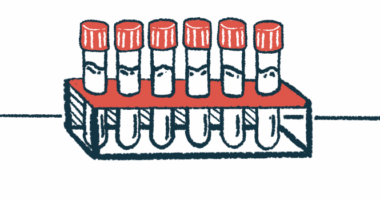ALS oral therapy slows disease progression in preclinical testing
Study: Drug candidate M102 also protected nerve cells from damage

- M102, an oral therapy for ALS, slowed disease progression in preclinical tests.
- It protects nerve cells by activating NRF2 and HSF1 pathways.
- The therapy improved muscle function and body weight in mouse models.
M102, an experimental oral therapy designed to simultaneously activate two molecular pathways that protect against nerve cell damage, showed promise in preclinical models of amyotrophic lateral sclerosis (ALS), according to a study.
The compound, discovered and developed by researchers at the University of Sheffield’s Institute for Translational Neuroscience (SITraN) in the U.K., significantly slowed disease progression and preserved muscle function in mouse models of the disease, as well as protected nerve cells from damage in lab experiments.
“The preclinical studies not only showed improvement in movement, gait, and nerve function in mouse models, but it also protected motor neurons grown in the laboratory from damage,” Pamela Shaw, co-author of the study and director of SITraN, said in a university news story.
The study, “M102 activates both NRF2 and HSF1 transcription factor pathways and is neuroprotective in cell and animal models of amyotrophic lateral sclerosis,” was published in Molecular Neurodegeneration.
M102 designed to simultaneously activate two molecular pathways
ALS, also called motor neuron disease or MND, is marked by the progressive degeneration and death of motor neurons, the specialized nerve cells that control movement.
The disease’s underlying causes aren’t fully understood, but a few molecular factors have been shown to play key roles. These include oxidative stress — a form of cell damage caused by highly reactive molecules that contain oxygen — as well as the misfolding and clumping up of certain proteins.
M102 is an oral small molecule designed to simultaneously activate two molecular pathways, called NRF2 and HSF1. The NRF2 pathway activates antioxidant mechanisms that help cells mitigate oxidative stress, while the HSF1 pathway plays key roles in stabilizing proteins to prevent abnormal folding and clumping.
“MND is one of the cruellest diseases, robbing people of their mobility and independence often at an alarming speed. We are now at a point where scientific understanding is finally catching up,” Shaw said. “Our discovery of M102 gives real hope that we can substantially slow the progression of this disease.”
The experimental therapy is currently being developed by Aclipse Therapeutics, which has received millions of dollars in grants to advance the therapy into clinical trials. Aclipse has been running preclinical tests to support an Investigational New Drug application, which is a formal request to U.S. authorities for permission to begin clinical testing in people. Aclipse is now planning to advance the therapy into clinical trials pending additional funding.
“Turning scientific discovery into real treatments takes teamwork — bringing together researchers, clinicians, industry partners, and investors,” said Richard Mead, PhD, co-author of the study and senior lecturer in translational neuroscience at SITraN. “Our collaboration with Aclipse Therapeutics has built that essential bridge between the research laboratory and the clinic. We’re now ready to take the next crucial step: testing M102 in people with MND and moving closer to a treatment that can truly make a difference.”
Treatment improved body weight, an indirect measure of ALS progression
In this study, scientists at SITraN and Aclipse presented preclinical data from mouse experiments showing that M102 activates both the NRF2 and HSF1 pathways as designed.
The scientists also detailed the outcomes of experiments with M102 in two mouse models of ALS: one caused by mutations in the SOD1 gene and another caused by mutations in the TDP-43 gene. Most cases of ALS aren’t associated with genetic mutations, but mutations in these genes underlie many cases of familial and sporadic ALS.
In the TDP-43 model, M102 treatment resulted in improvements in tests of muscle activity and measures of motor function. In the SOD1 model, the therapy was shown to preserve motor neurons. M102 treatment also helped improve body weight, an indirect measure of disease progression, in both models.
In other experiments, the researchers tested M102 in astrocytes derived from ALS patients, including those with genetic forms of ALS, as well as sporadic disease patients who had no known underlying mutations.
We have demonstrated that M102, a combined activator of NRF2 and HSF1 signalling pathways, has positive therapeutic effects in two different ALS transgenic mouse models and improves motor neuron survival and multiple pathological markers … in a range of human ALS cellular model systems.
Astrocytes are star-shaped cells that support nerve function in the brain and spinal cord. In ALS, they often exhibit significant oxidative stress and protein misfolding. However, both features were reduced with M102 treatment. In further tests where the patient-derived astrocytes were grown alongside motor neurons, M102 treatment improved the survival of the motor neurons.
“We have demonstrated that M102, a combined activator of NRF2 and HSF1 signalling pathways, has positive therapeutic effects in two different ALS transgenic mouse models and improves motor neuron survival and multiple pathological markers (i.e., oxidative stress, misfolded SOD1, TDP-43 …) in a range of human ALS cellular model systems,” the researchers wrote. “Importantly, these neuroprotective effects are seen across multiple subtypes of ALS, including the two most common genetic subtypes caused by mutations in the C9orf72 and SOD1 genes, as well as sporadic ALS cases.”
The researchers also conducted pharmacological tests and calculations to identify doses of M102 that are likely to be suitable for use in humans. The doses predicted to be effective in ALS patients were “well within the safety margin,” based on data from toxicology studies.








